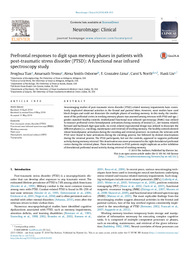| dc.contributor.author | Tian, Fenghua | |
| dc.contributor.author | Yennu, Amarnath | |
| dc.contributor.author | Smith-Osborne, Alexa | |
| dc.contributor.author | Gonzalez-Lima, F. | |
| dc.contributor.author | North, Carol S. | |
| dc.contributor.author | Liu, Hanli | |
| dc.date.accessioned | 2017-02-23T22:09:15Z | |
| dc.date.available | 2017-02-23T22:09:15Z | |
| dc.date.issued | 2014 | |
| dc.identifier.citation | Published in NeuroImage:Clinical 4:808-819, 2014 | en_US |
| dc.identifier.uri | http://hdl.handle.net/10106/26471 | |
| dc.description.abstract | Neuroimaging studies of post-traumatic stress disorder (PTSD)-related memory impairments have consistently implicated abnormal activities in the frontal and parietal lobes. However, most studies have used
block designs and could not dissociate the multiple phases of working memory. In this study, the involvement of the prefrontal cortex in working memory phases was assessed among veterans with PTSD and age-/
gender-matched healthy controls. Multichannel functional near infrared spectroscopy (fNIRS) was utilized
to measure prefrontal cortex hemodynamic activations during memory of neutral (i.e., not trauma-related)
forward and backward digit span tasks. An event-related experimental design was utilized to dissociate the
different phases (i.e., encoding, maintenance and retrieval) of working memory. The healthy controls showed
robust hemodynamic activations during the encoding and retrieval processes. In contrast, the veterans with
PTSD were found to have activations during the encoding process, but followed by distinct deactivations
during the retrieval process. The PTSD participants, but not the controls, appeared to suppress prefrontal
activity during memory retrieval. This deactivation was more pronounced in the right dorsolateral prefrontal
cortex during the retrieval phase. These deactivations in PTSD patients might implicate an active inhibition
of dorsolateral prefrontal neural activity during retrieval of working memory. | |
| dc.description.sponsorship | This work was supported in part by the Hogg Foundation for Men- tal Health, UT Arlington Research Enhancement fund, the Dallas Foun- dation, and private donors in support of the Student Veteran Project (SVP). The authors would like to thank all of the SVP clinicians, case managers, and veteran peer facilitators involved in this program for their assistance in recruiting and providing services to the veteran participants with PTSD. The authors would also like to thank Bejoy Mathai, M.S., Neha Khandelwal, M.S., and Nikita S. Bapat, M.S., for their assistance in the collection of fNIRS data. Dr. North discloses employment by VA North Texas Health Care System, Dallas, Texas, USA. The points of view in this document are those of the authors and do not necessarily represent the official position of the Department of Veterans Affairs or the United States Government. | en_US |
| dc.language.iso | en_US | en_US |
| dc.publisher | Elsevier Inc. | en_US |
| dc.rights | Attribution-NonCommercial-NoDerivs 3.0 United States | * |
| dc.rights.uri | http://creativecommons.org/licenses/by-nc-nd/3.0/us/ | * |
| dc.subject | Prefrontal cortex hemodynamic activations | en_US |
| dc.subject | Post-traumatic stress disorder | en_US |
| dc.subject | Hemispheric emotional valence (HEV) | en_US |
| dc.title | Prefrontal responses to digit span memory phases in patients with post-traumatic stress disorder (PTSD): A functional near infrared spectroscopy study | en_US |
| dc.type | Article | en_US |
| dc.publisher.department | Department of Bioengineering, The University of Texas at Arlington | en_US |
| dc.identifier.externalLinkDescription | The original publication is available at Article DOI | en_US |
| dc.identifier.doi | http://dx.doi.org/10.1016/j.nicl.2014.05.005 | |


